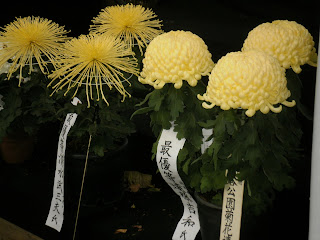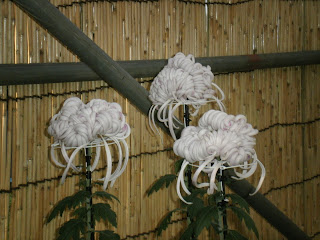

Quick! Before November ends, I had better write about this year's crop of Chrysanthemums (kiku in Japanese). The crest of the imperial family, kiku hold a special place among flora in Japan. But, as in many parts of the world, Japan also regards kiku as November's flower. And in their honor, magnificent exhibitions of the prize-winning plants are put on display every year at parks and other venues around town.



Before I saw one of these annual displays, I was quite indifferent to the densely petalled flowers. But now they dazzle me and no year is complete without a proper kiku viewing. Though the colors do not stray too far from the conventional yellow, white, pink or lavender, the unimaginable range of styles and shapes of displays -- bonsai miniatures to veritable cascades -- always move me. I am particularly partial to the solitary globes. Measuring a meter or more in height, some of these plants look like large softballs supported by leafy stems. Others resemble well-coiffed poodles.





I saw all of these perfect specimens at one of my favorite exhibits held at Hibiya Park, kitty-corner from the Imperial Palace and across the street from the Imperial Hotel. Laid out in the Meiji Period (late 19th century), the park's symmetrical plan, elegant promenades, wide flower beds and plazas punctuated by exuberant fountains were modeled after European precedents. The park's formality is the perfect backdrop for the luscious blooms.



















